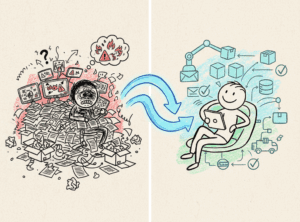AI shopping agents are everywhere these days – and if you’re running an E-Commerce business, you’re probably wondering if they’re friend or foe. It seems every week another platform is launching some version of an “AI-powered shopping assistant,” and the headlines swing between “Revolutionary!” and “Death of traditional retail!”
What do I think? Well, agentic E-Commerce isn’t just coming, it’s already here. Like most disruptive technologies, it’s not inherently good or bad for your business it is what you make it. It’s a new way of doing business that requires the right strategy, collaboration, and execution to work in your favour.
Here’s what you actually need to know (and what you can ignore) so you can make smart decisions for your business.
What Are AI Shopping Agents?
Let’s start with the basics. AI shopping agents are automated systems that can make purchasing decisions and complete transactions on behalf of consumers. Unlike chatbots that just answer questions, these agents actually take action – they search, compare, decide, and buy.
Here’s a scenario – First, you create yourself a weekly meal plan (tacos on Tuesday, pasta on Thursday, breakfast smoothies all week). From there, you have your AI shopping agent take that meal plan, search across multiple grocery retailers online, compare prices and availability, select the best combination of deals and inventory, and automatically places an order for curbside pickup. No manual searching, no comparing prices across sites yourself, no checkout steps required.
You just tell it “handle my groceries for the week” and it’s done. All you have to do is go to the store for the pickup on your way home from work. The future is here.
Other examples you’ve may have encountered include Google’s Shopping Graph Engine, Amazon’s Alexa making purchases through voice commands, or ChatGPT plugins that can browse and buy products directly within the conversation.The Myths & Real Fears (And What the Data Actually Shows)
I’ve been hearing and reading about anxiety from business owners regarding AI agents, and honestly, some of it’s justified, especially if you’re not prepared to adapt. That said, let me separate the myths from the real concerns using actual data.
Myth: AI agents will destroy human-driven commerce and customer relationships
The reality? According to a 2024 Coveo survey, 31% of consumers already expect to use virtual AI shopping assistants for product selection, and 72% anticipate enhanced online shopping experiences from generative AI. But here’s the interesting part – they’re not replacing human shopping entirely. They’re handling the tedious parts (price comparison, availability checking, routine replenishment) while humans focus on discovery, enjoyment, and complex decisions.
Fear: SMBs will get shut out or lose control of their brand
There’s some legitimacy here – if your site and data aren’t agent-ready, shopping agents either skip you or misrepresent you. The threat isn’t about big brands stealing the spotlight – it’s about technical readiness and agentic discoverability.
Real risks to watch out for
- Invisible to agents – messy or thin product feeds, missing identifiers (GTIN/MPN/SKU), no structured data, stale pricing or inventory, or conflicting info across channels. If agents can’t parse your catalogue cleanly, you won’t show up in shortlists.
- Brand messaging drift – agents scrape what’s on your site and feeds. If your PDPs, FAQs, shipping and returns, or size guides are inconsistent, the agent will echo the wrong story. One bad claim or outdated spec can become the “truth” the agent repeats.
- Lost sales paths – agents need a clear path to add-to-cart and fulfil. JS-only pages without server-side rendered (SSR) content, blocked faceted navigation, or slow/incomplete APIs may result in agents dropping your product for an easier option.
- No unified commerce – if store inventory, delivery windows, and return options aren’t exposed in one place, agents can’t compare fulfilment options or may not be able to confirm that your site meets the customers pre-approved criteria. You’ll lose to sellers who can show in-stock, arrival dates, and pickup options in real time.
- Integration gaps – missing or brittle endpoints for pricing, availability, and checkout; feeds that don’t refresh often; rate limits that throttle agents mid-journey. Agents will prefer sources that respond fast and reliably.
What to do now
- Fix the feed – complete attributes, clean identifiers, consistent titles, rich media, and current pricing and stock.
- Ship structured data – product schema, offers, variants, reviews, and policy info that’s machine-readable and accurate.
- Expose inventory and delivery promises – real-time stock by location, ETAs, and clear return rules via API.
- Make navigation agent-friendly – server-side render key pages, keep filters crawlable, use stable URLs, and support deep links to cart or checkout.
- Centralize the source of truth – use a single system of record (think PIM/OMS) to keep web, marketplaces, and stores in sync so agents see one consistent story.
If you’re unsure where you stand, start with a quick data and integration health check – I’ve outlined practical steps in a number of articles on our blog at https://www.cajefx.com/blog.
The Trust and Privacy Reality Check
Now for the legitimate concerns. While 24% of shoppers are comfortable letting AI agents shop on their behalf (jumping to 32% for Gen Z), and 70% of consumers are open to using AI agents for optimized shopping according to Salesforce, there are real barriers.
Privacy concerns top the list. When an AI agent has access to your shopping history, payment methods, and personal preferences, that’s a lot of sensitive data floating around. Many consumers are still wary about how this information gets used and shared.
There’s also the accuracy question. In a Criteo Shopper Survey, 49% of global shoppers used ChatGPT for product discovery in 2024 (up 27 points from the previous year), but early adopters report mixed results with purchase accuracy and satisfaction.
The Upsides for SMBs (Why This Could Be Your Secret Weapon)
Here’s where it gets interesting for smaller businesses. AI agents can actually level the playing field in ways that traditional E-Commerce never could.
Discovery Advantages
AI agents are great at surfacing niche products and brands that might get lost in traditional search results. If you sell specialty hiking gear, artisanal food products, or unique home goods, an AI agent focused on finding the “best” or “most suitable” option might recommend your products over generic alternatives – even if you don’t have the SEO budget of larger competitors.
Speed and Convenience Win
AI agents prioritize frictionless buying experiences. If your checkout process is smooth, your inventory data is accurate, and your customer service is responsive, you can compete effectively against larger retailers that might have more bureaucratic fulfillment processes.
Less Pay-to-Play (for now)
Today’s AI buying agents aren’t heavily influenced by ads – they’re tuned to reward relevance, clean data, strong service, and real customer proof. That gives smaller brands a rare window. You don’t need to run at a marketing loss spending ludicrous amounts of money on your social or search ads to win with agents – accurate product feeds, high-quality reviews, and dependable operations are bigger differentiators than budget right now. Will paid influence grow as agentic commerce matures? Likely. But at this moment, the playing field is far more level for brands that are optimized and customer-focused.
Unified Commerce Sweet Spot
This is huge – AI agents work best when they can access consistent, unified data across all your sales channels. If you’ve invested in proper unified commerce infrastructure, you’re already ahead of businesses that still manage separate systems for online, mobile, and retail operations.
The agent can see your real-time inventory, understand your shipping options, and present accurate information regardless of where the customer wants to receive their purchase. Larger retailers often struggle with this because their systems are more complex and fragmented.
The Real Operational Challenges
Let’s talk about what actually keeps me up at night when I’m helping businesses prepare for agentic commerce.
Data Quality is Everything
Your product descriptions, pricing, inventory levels, and shipping information need to be perfect. Not “pretty good” – perfect. AI agents don’t have patience for outdated stock levels or confusing product specs. If your data is messy, the agent will either skip your products entirely or present inaccurate information that leads to customer frustration.
Omnichannel Confusion
If your website says one thing, your mobile app says another, and your inventory system shows something different, AI agents get confused. They need unified, consistent information across every touchpoint. This means your backend systems need to talk to each other properly.
The Speed of Decision-Making
AI agents operate at machine speed. If a customer’s preferred product is out of stock, the agent might immediately pivot to a competitor’s alternative rather than wait for you to restock. You need to be able to respond to inventory changes, pricing adjustments, and fulfillment issues in real-time.
Customer Experience Standards
Remember, the AI agent is representing your brand to the customer. If the agent recommends your product but the delivery is late, the return process is complicated, or customer service is unresponsive, that reflects on both you and the AI platform. The standards for seamless experience are higher, not lower.
How SMBs Can Prepare (5 Actionable Steps)
Alright, enough theory. Here’s what you can actually do to prepare your business for agentic E-Commerce:
Step 1: Audit Your Data Foundation
Start with a complete audit of your product information across all channels. Check that your descriptions are comprehensive, your pricing is consistent, and your inventory levels update in real-time. If an AI agent can’t understand what you’re selling or whether it’s available, you’re invisible.
Step 2: Invest in Integration, Not Gadgets
Don’t rush to build your own AI shopping agent. Instead, focus on making your existing systems work together seamlessly. Unified commerce infrastructure, proper API connections, and clean data flows will serve you better than any shiny new AI tool.
Step 3: Optimize for Machine Readability
AI agents process information differently than human shoppers. Your product titles, descriptions, and specifications need to be clear and structured. Think about how you’d explain your product to someone who’s never seen it before – that’s how detailed your AI-facing content needs to be.
Step 4: Strengthen Your Fulfillment Game
AI agents will judge you based on delivery speed, accuracy, and return simplicity. If your fulfillment process has weak points, now’s the time to address them. Consider partnerships with third-party logistics providers if handling everything in-house is limiting your capabilities.
Step 5: Monitor and Adapt
Set up systems to track how AI agents are interacting with your business. Which products are they recommending? Where are they finding pricing or availability issues? What questions are they asking that you can’t answer? This feedback will guide your optimization efforts.
Getting Ahead of the Curve
The businesses that thrive with AI shopping agents won’t be the ones with the biggest marketing budgets or the flashiest technology. They’ll be the ones that understand their customers deeply, maintain excellent operational standards, and adapt quickly to new ways of reaching those customers.
AI agents aren’t “bad” for E-Commerce – they’re just different. And different creates opportunities for businesses that are prepared and challenges for those that aren’t.
If you’re feeling overwhelmed by all this, you’re not alone. The intersection of AI technology, E-Commerce operations, and customer experience is complex, and it’s changing rapidly.
The good news? (Shameless plug alert!) You don’t have to figure it out alone. At CajeFX, we help E-Commerce businesses navigate these technological shifts while keeping their operations running smoothly. We can audit your current readiness for agentic commerce, identify the gaps that need addressing, and build a practical implementation plan that fits your budget and timeline.





